Financial Analysis and Investment Appraisal of RP Plc
VerifiedAdded on 2023/06/07
|9
|1465
|353
AI Summary
This article provides a comprehensive financial analysis and investment appraisal of RP Plc, including its profitability, liquidity, and efficiency ratios. It also includes a detailed calculation of ARR, NPV, and payback period, along with the advantages of IRR. The article also suggests five other factors that need to be considered before making an investment decision.
Contribute Materials
Your contribution can guide someone’s learning journey. Share your
documents today.

ONLINE EXAM
Secure Best Marks with AI Grader
Need help grading? Try our AI Grader for instant feedback on your assignments.
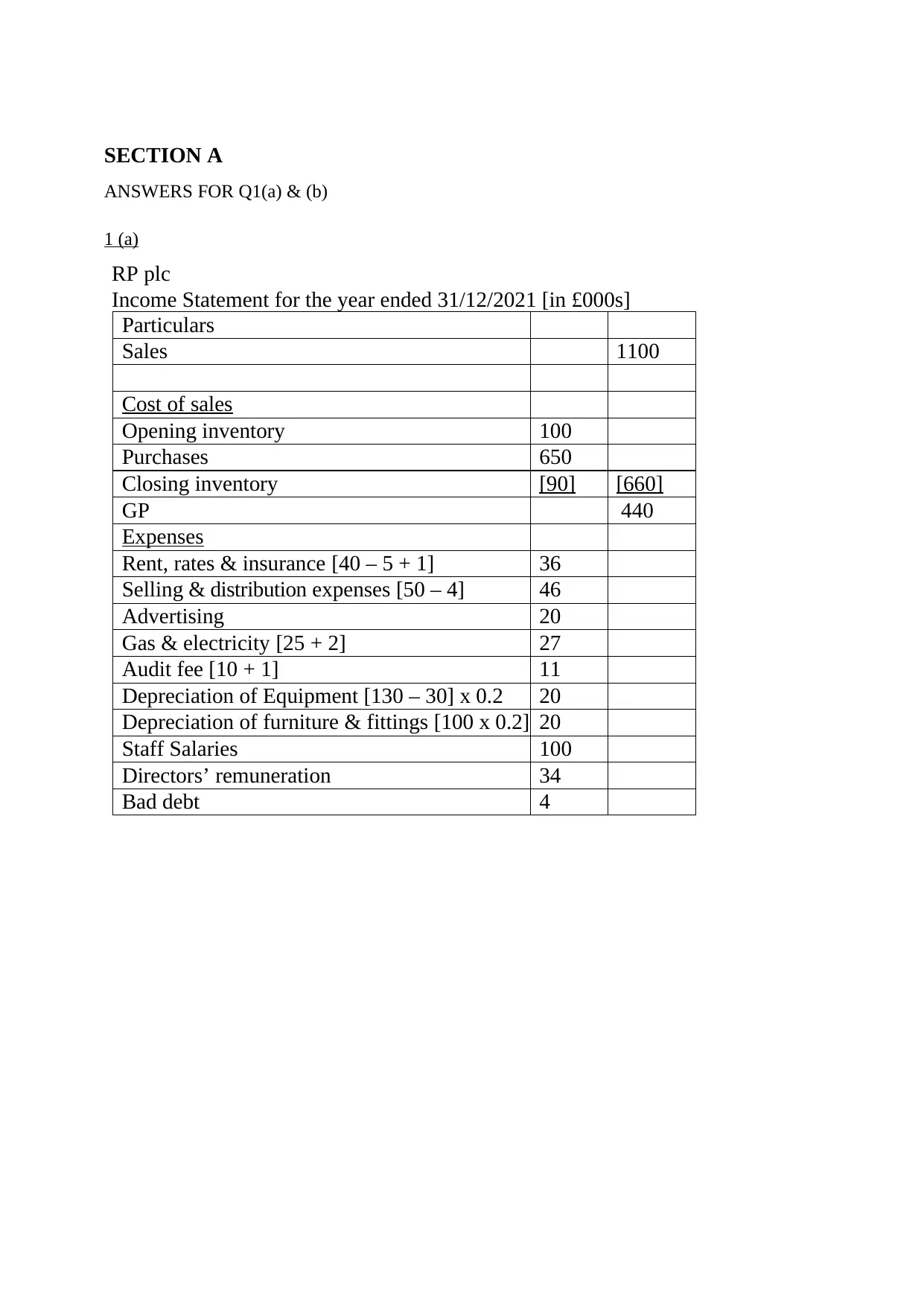
SECTION A
ANSWERS FOR Q1(a) & (b)
1 (a)
RP plc
Income Statement for the year ended 31/12/2021 [in £000s]
Particulars
Sales 1100
Cost of sales
Opening inventory 100
Purchases 650
Closing inventory [90] [660]
GP 440
Expenses
Rent, rates & insurance [40 – 5 + 1] 36
Selling & distribution expenses [50 – 4] 46
Advertising 20
Gas & electricity [25 + 2] 27
Audit fee [10 + 1] 11
Depreciation of Equipment [130 – 30] x 0.2 20
Depreciation of furniture & fittings [100 x 0.2] 20
Staff Salaries 100
Directors’ remuneration 34
Bad debt 4
ANSWERS FOR Q1(a) & (b)
1 (a)
RP plc
Income Statement for the year ended 31/12/2021 [in £000s]
Particulars
Sales 1100
Cost of sales
Opening inventory 100
Purchases 650
Closing inventory [90] [660]
GP 440
Expenses
Rent, rates & insurance [40 – 5 + 1] 36
Selling & distribution expenses [50 – 4] 46
Advertising 20
Gas & electricity [25 + 2] 27
Audit fee [10 + 1] 11
Depreciation of Equipment [130 – 30] x 0.2 20
Depreciation of furniture & fittings [100 x 0.2] 20
Staff Salaries 100
Directors’ remuneration 34
Bad debt 4

Interest on bank loan 7
Debenture interest [10 + 1] 11 [336]
PBT 104
Provision for taxation [25]
PAT 79
Dividends – interim
-- final [350 x £0.08]
20
28 [48]
Retained profit for the year 31
Retained profit b/f 70
Retained profit c/f 101
1 (b)
RP plc
Statement Of Financial Position as at 31/12/2021 [in £000s]
Non-current assets Cost Accumulated
Depreciation
NBV
Premises 600 --- 600
Equipment 130 30 + 20 = 50 80
Furnitures & fittings 100 60 + 20 = 80 20
830 130 700
Current assets
Inventory 90
Receivables 87
Prepayments [5 + 4] 9
Bank 9
Cash 4 199
Total assets 899
Share capital
£1 Ordinary shares 350
Reserves
Share premium 120
Retained profits 101
Shareholders’ funds 571
Non-current liabilities
7% Long term bank loan 100
11% Debentures 100 200
Current liabilities
Debenture interest [10 + 1] 11 [336]
PBT 104
Provision for taxation [25]
PAT 79
Dividends – interim
-- final [350 x £0.08]
20
28 [48]
Retained profit for the year 31
Retained profit b/f 70
Retained profit c/f 101
1 (b)
RP plc
Statement Of Financial Position as at 31/12/2021 [in £000s]
Non-current assets Cost Accumulated
Depreciation
NBV
Premises 600 --- 600
Equipment 130 30 + 20 = 50 80
Furnitures & fittings 100 60 + 20 = 80 20
830 130 700
Current assets
Inventory 90
Receivables 87
Prepayments [5 + 4] 9
Bank 9
Cash 4 199
Total assets 899
Share capital
£1 Ordinary shares 350
Reserves
Share premium 120
Retained profits 101
Shareholders’ funds 571
Non-current liabilities
7% Long term bank loan 100
11% Debentures 100 200
Current liabilities
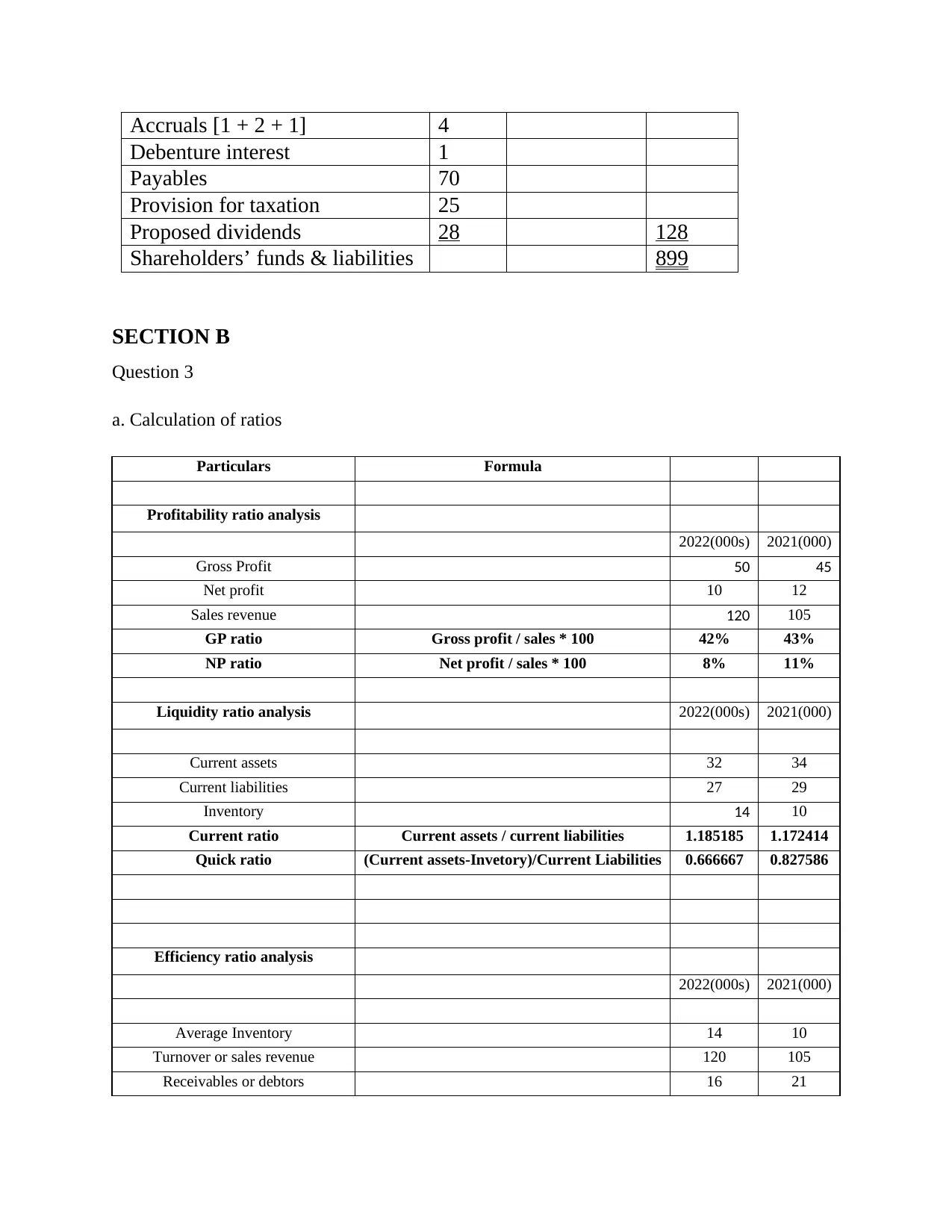
Accruals [1 + 2 + 1] 4
Debenture interest 1
Payables 70
Provision for taxation 25
Proposed dividends 28 128
Shareholders’ funds & liabilities 899
SECTION B
Question 3
a. Calculation of ratios
Particulars Formula
Profitability ratio analysis
2022(000s) 2021(000)
Gross Profit 50 45
Net profit 10 12
Sales revenue 120 105
GP ratio Gross profit / sales * 100 42% 43%
NP ratio Net profit / sales * 100 8% 11%
Liquidity ratio analysis 2022(000s) 2021(000)
Current assets 32 34
Current liabilities 27 29
Inventory 14 10
Current ratio Current assets / current liabilities 1.185185 1.172414
Quick ratio (Current assets-Invetory)/Current Liabilities 0.666667 0.827586
Efficiency ratio analysis
2022(000s) 2021(000)
Average Inventory 14 10
Turnover or sales revenue 120 105
Receivables or debtors 16 21
Debenture interest 1
Payables 70
Provision for taxation 25
Proposed dividends 28 128
Shareholders’ funds & liabilities 899
SECTION B
Question 3
a. Calculation of ratios
Particulars Formula
Profitability ratio analysis
2022(000s) 2021(000)
Gross Profit 50 45
Net profit 10 12
Sales revenue 120 105
GP ratio Gross profit / sales * 100 42% 43%
NP ratio Net profit / sales * 100 8% 11%
Liquidity ratio analysis 2022(000s) 2021(000)
Current assets 32 34
Current liabilities 27 29
Inventory 14 10
Current ratio Current assets / current liabilities 1.185185 1.172414
Quick ratio (Current assets-Invetory)/Current Liabilities 0.666667 0.827586
Efficiency ratio analysis
2022(000s) 2021(000)
Average Inventory 14 10
Turnover or sales revenue 120 105
Receivables or debtors 16 21
Secure Best Marks with AI Grader
Need help grading? Try our AI Grader for instant feedback on your assignments.

Creditors or payables 12 13
Cost of ggod sold 70 70
Receivables or debtors turnover
ratio (in days)
(Debtors * 365) / Credit sales 48.66667 73
Creditors turnover ratio (in days) (Creditors * 365) / COGS 62.57143 67.78571
Inventory Holding Days Ratio Sales/Inventory*365 42.58333 34.7619
b. Commenting on the performance of the company for the two years on the basis of above ratios
Profitability analysis: In the above table, for determining the profitability of the company, net
profit margins and gross profit margins have been calculated which are decreasing from 2021 to
2022 indicating poor profitability of the company. As the sales revenue has increased, the
reduction in profit margins can be attributed to poor efficiency of the business generating sales
for the business.
Liquidity analysis: Two ratios that is, current ratio and quick ratio have been calculated for
determining the liquidity of PD limited. Both of these ratios have reduced between 2021 and
2022 indicating that the company might be going to face liquidity issues in the near future. The
ideal current ratio is 2, however, this company is having less than 2 current ratio which means
the company is not capable of meeting its short terms obligations. Further, the ideal quick ratio is
1 and this company is having its quick ratio less than 1 both in 2021 and 2022 indicating that the
company would face difficulty in meeting its obligations immediately if it would arise in the
short run of one year.
Efficiency analysis: As the receivables ratio has reduced from 73 days to 48 days in 2022, it
means the efficiency of company has improved in collecting its outstanding debt. Also, the
payables ratio has reduced from 67 days to 62 days in 2022 indicating that the company is
meeting its outside obligations earlier in 2022 as compared to 2021 which means the company’s
solvency and liquidity has improved. However, the inventory holding period has increased from
34 days to 42 days in 2022 indicating that the company is taking more time in converting its
inventory into sales of the company. Thus, signifies poor efficiency in generating sales.
Question 4
Relevant annual profit and cash flow
Selling price per unit is 30 and variable cost per unit is 20
Cost of ggod sold 70 70
Receivables or debtors turnover
ratio (in days)
(Debtors * 365) / Credit sales 48.66667 73
Creditors turnover ratio (in days) (Creditors * 365) / COGS 62.57143 67.78571
Inventory Holding Days Ratio Sales/Inventory*365 42.58333 34.7619
b. Commenting on the performance of the company for the two years on the basis of above ratios
Profitability analysis: In the above table, for determining the profitability of the company, net
profit margins and gross profit margins have been calculated which are decreasing from 2021 to
2022 indicating poor profitability of the company. As the sales revenue has increased, the
reduction in profit margins can be attributed to poor efficiency of the business generating sales
for the business.
Liquidity analysis: Two ratios that is, current ratio and quick ratio have been calculated for
determining the liquidity of PD limited. Both of these ratios have reduced between 2021 and
2022 indicating that the company might be going to face liquidity issues in the near future. The
ideal current ratio is 2, however, this company is having less than 2 current ratio which means
the company is not capable of meeting its short terms obligations. Further, the ideal quick ratio is
1 and this company is having its quick ratio less than 1 both in 2021 and 2022 indicating that the
company would face difficulty in meeting its obligations immediately if it would arise in the
short run of one year.
Efficiency analysis: As the receivables ratio has reduced from 73 days to 48 days in 2022, it
means the efficiency of company has improved in collecting its outstanding debt. Also, the
payables ratio has reduced from 67 days to 62 days in 2022 indicating that the company is
meeting its outside obligations earlier in 2022 as compared to 2021 which means the company’s
solvency and liquidity has improved. However, the inventory holding period has increased from
34 days to 42 days in 2022 indicating that the company is taking more time in converting its
inventory into sales of the company. Thus, signifies poor efficiency in generating sales.
Question 4
Relevant annual profit and cash flow
Selling price per unit is 30 and variable cost per unit is 20
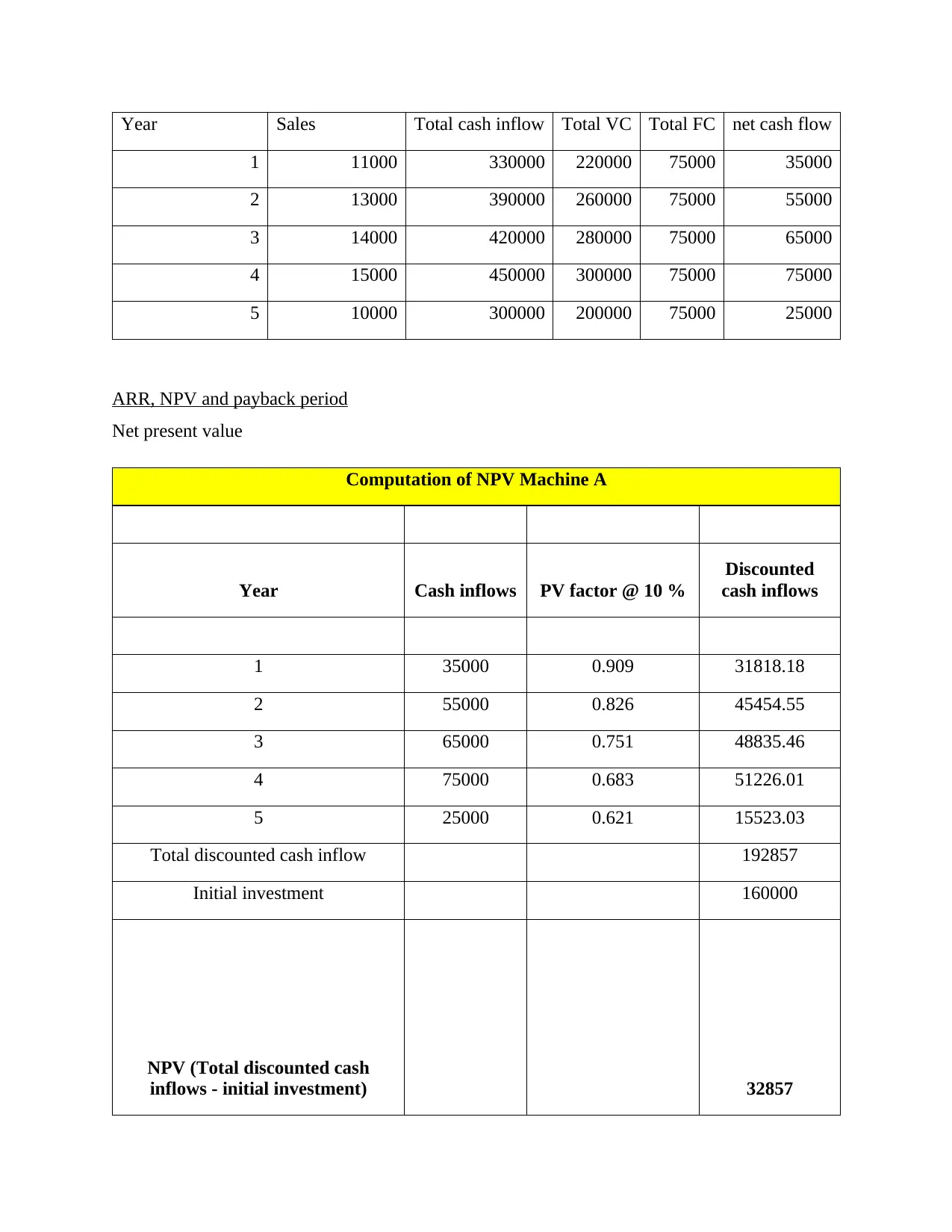
Year Sales Total cash inflow Total VC Total FC net cash flow
1 11000 330000 220000 75000 35000
2 13000 390000 260000 75000 55000
3 14000 420000 280000 75000 65000
4 15000 450000 300000 75000 75000
5 10000 300000 200000 75000 25000
ARR, NPV and payback period
Net present value
Computation of NPV Machine A
Year Cash inflows PV factor @ 10 %
Discounted
cash inflows
1 35000 0.909 31818.18
2 55000 0.826 45454.55
3 65000 0.751 48835.46
4 75000 0.683 51226.01
5 25000 0.621 15523.03
Total discounted cash inflow 192857
Initial investment 160000
NPV (Total discounted cash
inflows - initial investment) 32857
1 11000 330000 220000 75000 35000
2 13000 390000 260000 75000 55000
3 14000 420000 280000 75000 65000
4 15000 450000 300000 75000 75000
5 10000 300000 200000 75000 25000
ARR, NPV and payback period
Net present value
Computation of NPV Machine A
Year Cash inflows PV factor @ 10 %
Discounted
cash inflows
1 35000 0.909 31818.18
2 55000 0.826 45454.55
3 65000 0.751 48835.46
4 75000 0.683 51226.01
5 25000 0.621 15523.03
Total discounted cash inflow 192857
Initial investment 160000
NPV (Total discounted cash
inflows - initial investment) 32857
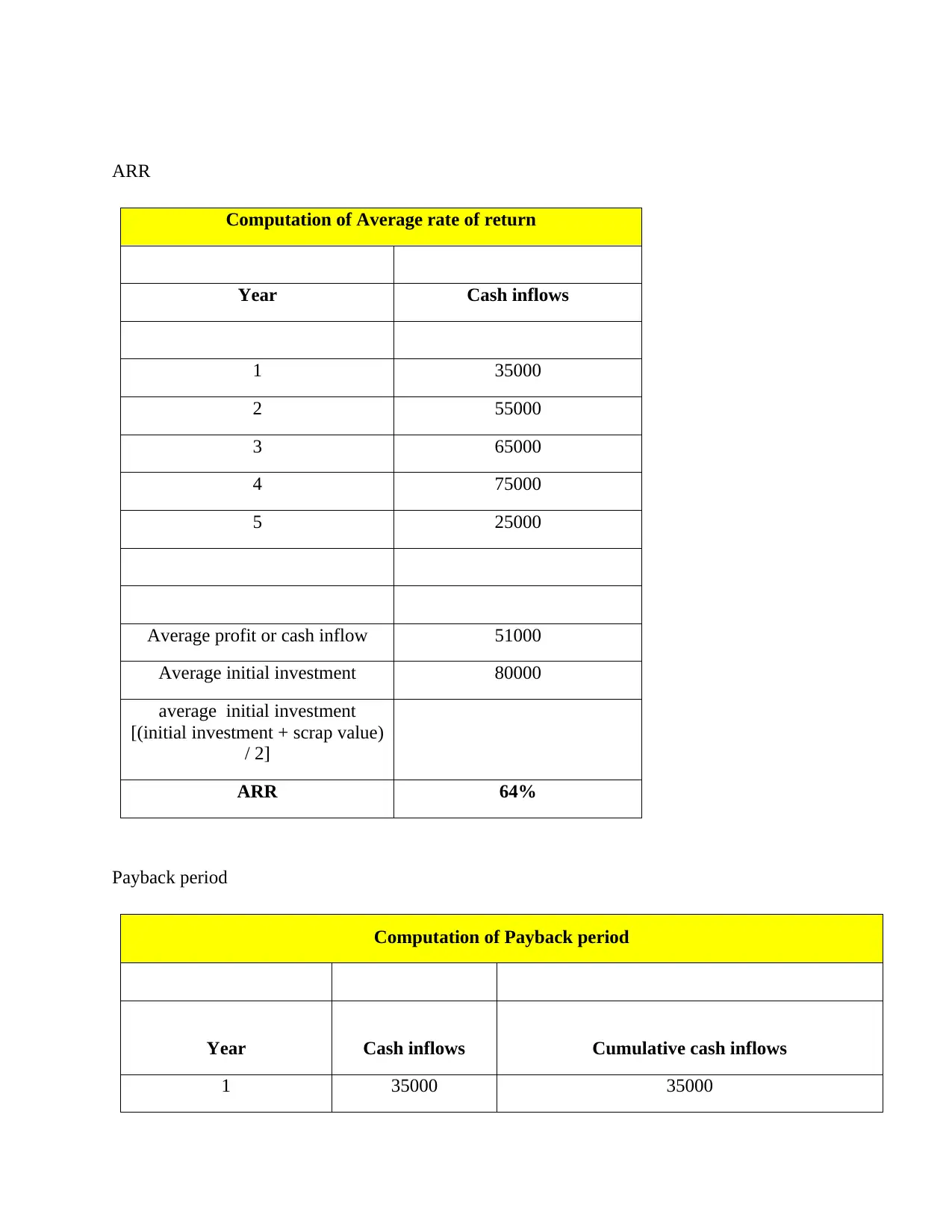
ARR
Computation of Average rate of return
Year Cash inflows
1 35000
2 55000
3 65000
4 75000
5 25000
Average profit or cash inflow 51000
Average initial investment 80000
average initial investment
[(initial investment + scrap value)
/ 2]
ARR 64%
Payback period
Computation of Payback period
Year Cash inflows Cumulative cash inflows
1 35000 35000
Computation of Average rate of return
Year Cash inflows
1 35000
2 55000
3 65000
4 75000
5 25000
Average profit or cash inflow 51000
Average initial investment 80000
average initial investment
[(initial investment + scrap value)
/ 2]
ARR 64%
Payback period
Computation of Payback period
Year Cash inflows Cumulative cash inflows
1 35000 35000
Paraphrase This Document
Need a fresh take? Get an instant paraphrase of this document with our AI Paraphraser
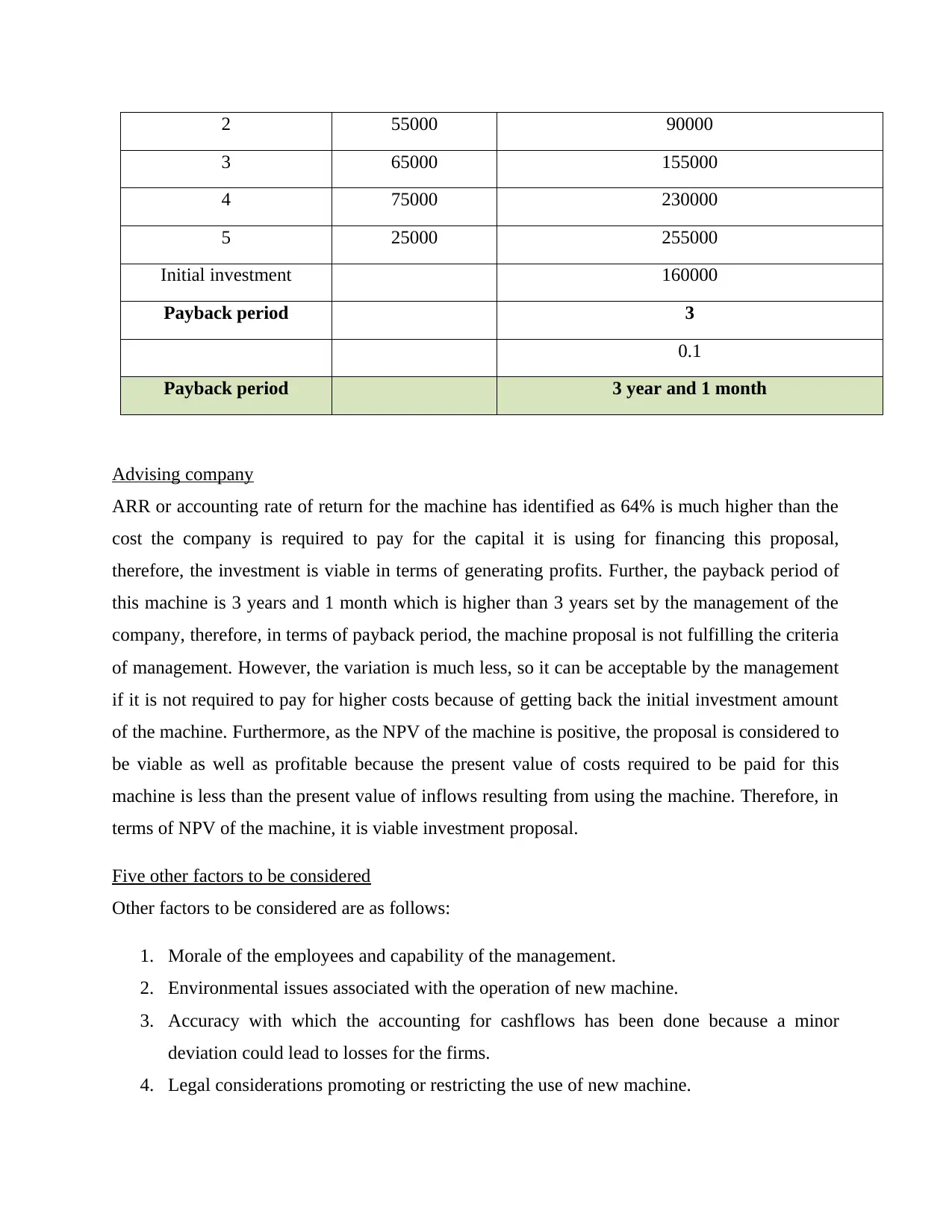
2 55000 90000
3 65000 155000
4 75000 230000
5 25000 255000
Initial investment 160000
Payback period 3
0.1
Payback period 3 year and 1 month
Advising company
ARR or accounting rate of return for the machine has identified as 64% is much higher than the
cost the company is required to pay for the capital it is using for financing this proposal,
therefore, the investment is viable in terms of generating profits. Further, the payback period of
this machine is 3 years and 1 month which is higher than 3 years set by the management of the
company, therefore, in terms of payback period, the machine proposal is not fulfilling the criteria
of management. However, the variation is much less, so it can be acceptable by the management
if it is not required to pay for higher costs because of getting back the initial investment amount
of the machine. Furthermore, as the NPV of the machine is positive, the proposal is considered to
be viable as well as profitable because the present value of costs required to be paid for this
machine is less than the present value of inflows resulting from using the machine. Therefore, in
terms of NPV of the machine, it is viable investment proposal.
Five other factors to be considered
Other factors to be considered are as follows:
1. Morale of the employees and capability of the management.
2. Environmental issues associated with the operation of new machine.
3. Accuracy with which the accounting for cashflows has been done because a minor
deviation could lead to losses for the firms.
4. Legal considerations promoting or restricting the use of new machine.
3 65000 155000
4 75000 230000
5 25000 255000
Initial investment 160000
Payback period 3
0.1
Payback period 3 year and 1 month
Advising company
ARR or accounting rate of return for the machine has identified as 64% is much higher than the
cost the company is required to pay for the capital it is using for financing this proposal,
therefore, the investment is viable in terms of generating profits. Further, the payback period of
this machine is 3 years and 1 month which is higher than 3 years set by the management of the
company, therefore, in terms of payback period, the machine proposal is not fulfilling the criteria
of management. However, the variation is much less, so it can be acceptable by the management
if it is not required to pay for higher costs because of getting back the initial investment amount
of the machine. Furthermore, as the NPV of the machine is positive, the proposal is considered to
be viable as well as profitable because the present value of costs required to be paid for this
machine is less than the present value of inflows resulting from using the machine. Therefore, in
terms of NPV of the machine, it is viable investment proposal.
Five other factors to be considered
Other factors to be considered are as follows:
1. Morale of the employees and capability of the management.
2. Environmental issues associated with the operation of new machine.
3. Accuracy with which the accounting for cashflows has been done because a minor
deviation could lead to losses for the firms.
4. Legal considerations promoting or restricting the use of new machine.
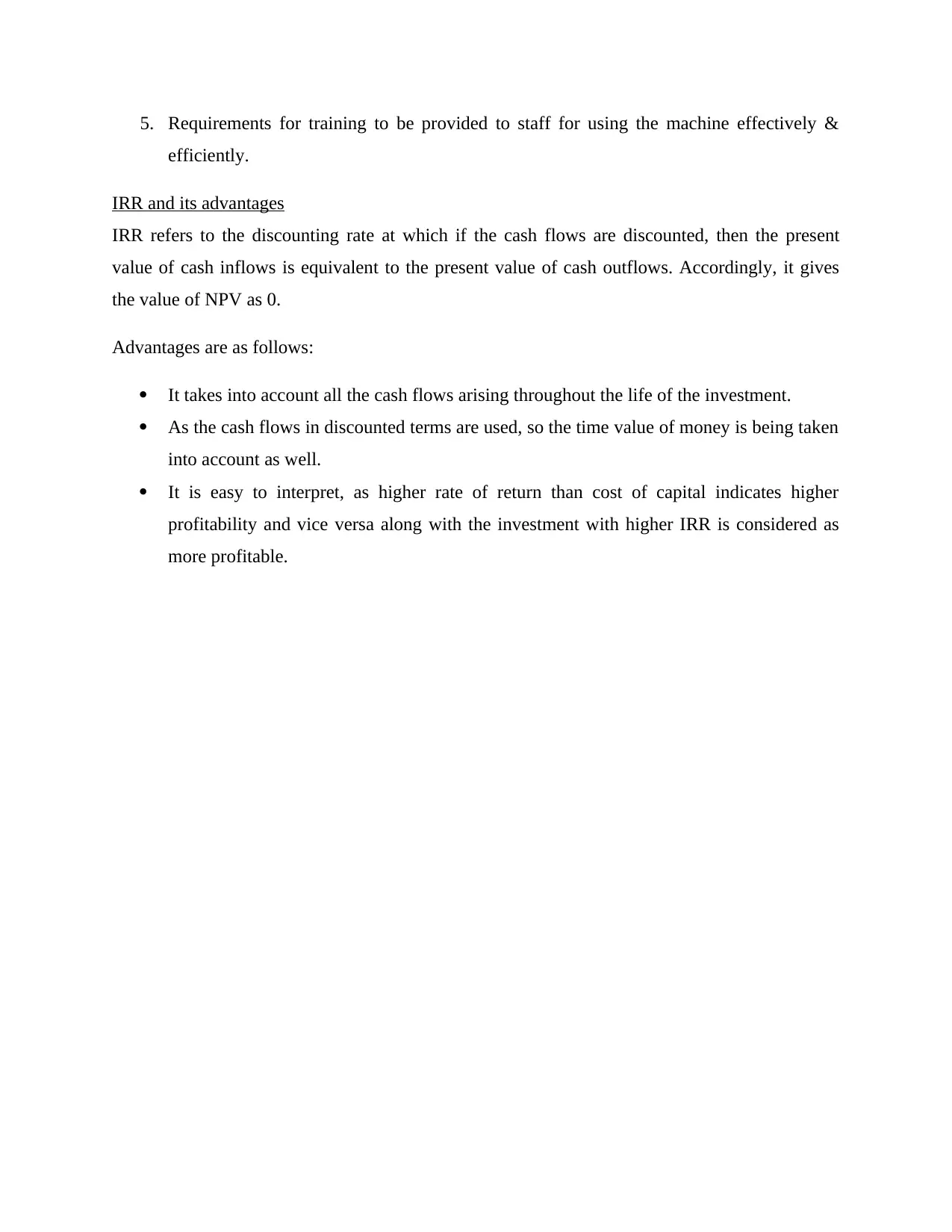
5. Requirements for training to be provided to staff for using the machine effectively &
efficiently.
IRR and its advantages
IRR refers to the discounting rate at which if the cash flows are discounted, then the present
value of cash inflows is equivalent to the present value of cash outflows. Accordingly, it gives
the value of NPV as 0.
Advantages are as follows:
It takes into account all the cash flows arising throughout the life of the investment.
As the cash flows in discounted terms are used, so the time value of money is being taken
into account as well.
It is easy to interpret, as higher rate of return than cost of capital indicates higher
profitability and vice versa along with the investment with higher IRR is considered as
more profitable.
efficiently.
IRR and its advantages
IRR refers to the discounting rate at which if the cash flows are discounted, then the present
value of cash inflows is equivalent to the present value of cash outflows. Accordingly, it gives
the value of NPV as 0.
Advantages are as follows:
It takes into account all the cash flows arising throughout the life of the investment.
As the cash flows in discounted terms are used, so the time value of money is being taken
into account as well.
It is easy to interpret, as higher rate of return than cost of capital indicates higher
profitability and vice versa along with the investment with higher IRR is considered as
more profitable.
1 out of 9
Your All-in-One AI-Powered Toolkit for Academic Success.
+13062052269
info@desklib.com
Available 24*7 on WhatsApp / Email
![[object Object]](/_next/static/media/star-bottom.7253800d.svg)
Unlock your academic potential
© 2024 | Zucol Services PVT LTD | All rights reserved.



